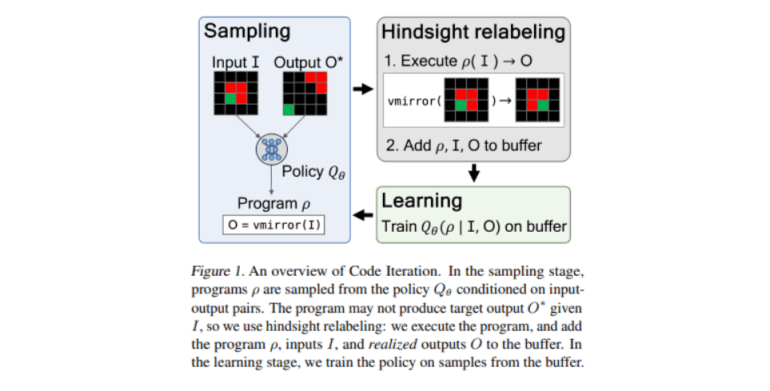TL;DR:
- Qualcomm AI Research introduces CodeIt, combining Program Sampling and Hindsight Relabeling for Program Synthesis.
- Programming by example aims to automate processes by generating programs from input-output examples.
- Current methods struggle with tasks requiring abstraction and reasoning, highlighted by benchmarks like ARC.
- CodeIt addresses these challenges by iteratively refining models through self-improvement, leveraging pre-trained language models.
- It employs a two-stage method emphasizing object-centric grid representation and policy creation.
- CodeIt demonstrates notable efficacy, solving 15% of ARC evaluation tasks and surpassing existing baselines.
Main AI News:
Researchers at Qualcomm AI Research have unveiled a groundbreaking solution named CodeIt, which seamlessly merges Program Sampling with Hindsight Relabeling for Program Synthesis. This innovation comes as a boon in the realm of Artificial Intelligence (AI), particularly in automating processes. The crux of programming by example lies in generating programs based on input-output examples, necessitating a system capable of discerning underlying patterns and extrapolating them to unseen instances.
Despite significant strides, existing methods in programming by example often stumble when confronted with tasks demanding high levels of abstraction and reasoning. The complexity inherent in such tasks lies in the need for solutions to generalize from a limited set of examples to a wide array of scenarios. Notably, benchmarks like the Abstraction and Reasoning Corpus (ARC) underscore this challenge, evaluating AI systems’ capacity to apply core knowledge systems in novel contexts.
Existing strategies to tackle these hurdles fall into two camps: neural and neuro-symbolic methods. While neural approaches aim to predict output grids directly from input grids using deep learning models, neuro-symbolic methods delve into understanding the mapping between input and output grids through symbolic representations before generating the desired outputs. However, both approaches often grapple with task generalization due to the sparse rewards in program synthesis.
In response to these challenges, researchers from the University of Amsterdam have introduced Code Iteration (CodeIt), a novel approach that navigates between program sampling with hindsight relabeling and learning from prioritized experience replay. This iterative method empowers models to refine their understanding and enhance predictions through self-improvement, leveraging pre-trained language models while mitigating reward sparsity issues.
The study reframes the ARC challenge as a programming-by-examples conundrum, employing a two-stage method: program generation through policy application with hindsight relabeling and iterative learning from input-output pairs. Central to this approach is the utilization of object-centric grid representation, facilitated by Hodel’s open-source Domain-specific language (DSL) for grid manipulation and the pretrained CodeT5+ LLM for policy creation.
Underpinned by a rigorous training regimen involving 400 ARC training examples and an expanded dataset of 19,200 program samples, the CodeIt Algorithm demonstrates notable efficacy. Implementation on the ARC dataset yielded remarkable results, with CodeIt solving 15% of the evaluation tasks, surpassing existing neural and symbolic baselines. The method’s effectiveness in navigating the extreme sparsity of rewards in program synthesis underscores its promise in advancing AI-driven automation processes.
Conclusion:
The unveiling of CodeIt by Qualcomm AI Research signifies a significant leap forward in the field of program synthesis. By addressing the challenges of abstraction and reasoning inherent in programming by example, CodeIt promises to revolutionize automation processes. Its remarkable efficacy in solving ARC evaluation tasks and surpassing existing baselines highlights its potential to reshape the market landscape, driving innovation and efficiency in AI-driven automation solutions.

